General Information - General information on the Outdoor Literature course (PE 4440) is found at the main page.
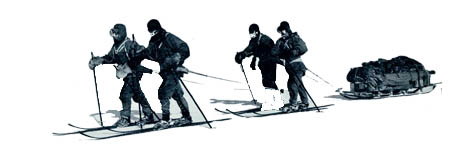
Outdoor History - As a part of this course, we will be studying the history of outdoor adventure, and as we look at outdoor adventure, we will do so through the lens of the generations. I will using some of the concepts and materials that come from the work of William Strauss and Neil Howe in their ground breaking work Generations: The History of America's Future, 1584 to 2069.[1] Strauss and Howe suggest that history is a succession of generations, and that each generation belongs to one of four types which repeat sequentially in a fixed pattern.
We'll use Strauss and Howe's work as a way of looking at the history of outdoor adventure, but you should also know that historians point to a number of problems with their theories, not the least of which is a lack of rigorous empirical evidence. Nevertheless, viewing history through the eyes of the generations is fascinating stuff and, in a number of ways, more instructive and meaningful than traditional methods.
More about generations shortly. In particular, we will start with the early to mid 1800's since this period represents a time when attitudes toward exploring and adventure changed. This is the beginning of what I call the "Modern Age of Adventure." [2]
Definition of Modern Age of Adventure. The term "Modern Age of Adventure" can be interpreted in different ways, but for the purposes of this study, it is defined as a period of time starting in the early to mid 1800s and extending to the present. From an historical perspective, the early and mid nineteenth century marks an important change in attitude about adventure and exploration. Not all, but most previous exploration was undertaken for exploitation. The Modern Age of Adventure begins when explorers went exploring for the sake of exploration—not for financial gain, not for colonial expansion, and not for the purpose of religious conversion. There always have been individuals in history who have been motivated purely by adventure, most certainly, but for the great bulk of explorers prior to the Modern Age of Adventure, other materialistic rewards loomed larger. The early 1800s represent a watershed, a turning of the tide.
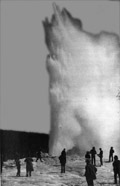 The Modern Age is similar in some respects with what historian William H. Goetzmann calls the "Second Age of Discovery."
[3]
Both were possible because of developments in literature, science and the arts. But they are different. Goetzman's Second Age begins at least a hundred years earlier and encompasses exploration and discovery on behalf of science. It was the Enlightenment, the turn away from superstition and irrationality, which paved the way for the Second Age. On the other hand, it is the Romantic Movement with its emphasis on nature which cleared the way for the Modern Age. The Modern Age is also limited to outdoor adventure activities (as defined above). Science may play a role in an adventurous activity—and science may even be used to give it legitimacy—but the underlying motivation for the activity is adventure.
The Modern Age is similar in some respects with what historian William H. Goetzmann calls the "Second Age of Discovery."
[3]
Both were possible because of developments in literature, science and the arts. But they are different. Goetzman's Second Age begins at least a hundred years earlier and encompasses exploration and discovery on behalf of science. It was the Enlightenment, the turn away from superstition and irrationality, which paved the way for the Second Age. On the other hand, it is the Romantic Movement with its emphasis on nature which cleared the way for the Modern Age. The Modern Age is also limited to outdoor adventure activities (as defined above). Science may play a role in an adventurous activity—and science may even be used to give it legitimacy—but the underlying motivation for the activity is adventure.
Generations - Since our course covers a time period encompassed by the Modern Age of Adventure, we will be studying ten generations identified by Straus and Howe from the late 1700s to present. Before listing the actual generations, let's look at some basic concepts.
Concepts of Generational Analysis
There are several key concepts which form the basis of Strauss and Howe's work. The first of these is Social Movements.
Social Movements consist of two major sub-categories: secular crises and spiritual awakenings. Secular crises are times of widespread fear for one's own safety and the safety of one's way of life. Primarily these are times of war or extreme economic hardship. An example is the Civil War.
Spiritual awakenings, on the other hand, are periodic times in history when there is a society wide interest in self-examination: finding meaning or seeking a higher purpose in life. An example is the Boom Awakening which occurred during the 1960s and early 1970s. During this time, many young people were involved in what might be described as inner journeys directed toward greater personal understanding. Some experimented with mind-altering drugs. Others joined communes or took up studies of eastern religions. And, yes, still others found transitory meaning in nature and outdoor activity.
As they investigated American history, Strauss and Howe found a repeating pattern of social movements which they could trace back to 1584. Remarkably, they found that Secular Crises and Spiritual Awakenings alternated with one another. Each movement was separated by two generations, occurring approximately every 40-45 years.
Another concept which is helpful in understanding generational history is that of life phases. See: Life Phases Hand-out
Generations in American History
With this background, let's take a look at specific generations identified by Strauss and Howe. As mentioned above, it is not necessary to go back in history to the 1500s. Rather, from the context of this paper, we'll concentrate on generations beginning with the Modern Age of Adventure in the early 1800s. The years shown in parenthesis, below, are birth years. (A copy of the following is also found: here)
Transcendental (b. 1792-1821). Idealistic Type. Leaders during civil war. Rapid expansion of evangelical religion. Great interest among the literati in transcendental philosophy. Examples: Abraham Lincoln, Brigham Young, Ralph Waldo Emerson, Henry Wadsworth Longfellow, Henry David Thoreau.
Gilded (b. 1822-1842). Reactive Type. Soldiers in Civil War. Came of age in era economic swings. Pragmatic and a bit jaded. Defined today's image of the western: youthful 49's, Pony Express Riders, ranchers, cowboys, Indian fighters. Examples: Mark Twain, Wild Bill Hickok, George Custer.
Progressive (b. 1843-1859). Adaptive Type. Children during Civil War. Good organizers. Founded many enduring fraternal, labor, academic and professional organizations. Examples: Thomas Edison, Henry James, Theodore Roosevelt.
Missionary (b. 1860-1882). Idealistic Type. Sparked the greatest wave of campus rebellions since the 1830s. Boom era for youthful outdoor sports: golf, tennis, roller skating and bicycling. Women reinvented bloomers (called "rationals" for bicycle riding. Went at life with a missionary zeal: social reformers and moral pathfinders. The Missionary Generation fought for and obtained a woman's right to vote and also passed prohibition amendment. Examples: Upton Sinclair, Frank Lloyd Wright, Orville Wright, Albert Einstein.
Lost (b. 1883-1900). Reactive Type. Soldiers of World War I. Spawned the "Roaring Twenties" and the "Jazz Age." Morals were looser. Crime soared. Era of prohibition: bootlegging and speak easies. Examples: Ernest Hemingway, F. Scott Fitzgerald.
GI (b. 1901-1924). Civic Type. Soldiers of World War II. A heroic generation. Tom Brokaw has called them the "Greatest Generation." Won the war and built America into a world power. Examples: John F. Kennedy, Ronald Reagan, Walter Cronkite, John Wayne, John Steinbeck.
Silent (b. 1925-1942). Adaptive Type. Minimized risk. Security was of overriding importance. Would rather work for large corporations. This generation produced presidential aides but no presidents. They found themselves between the get-it-done GI's and self-absorbed Boomers. A number of first wavers saw action in WWII, but few saw action before being sent home. Their war was the Korean War—and when most people think of the Korean War, they think of the TV series "Mash." Examples: Marilyn Monroe, Woody Allen, Michael Dukakis, Jesse Jackson.
Boom (b. 1943-1960). Idealistic Type. Generation of antiwar protests, of free love, and the "Consciousness Revolution." Spiritualism was more important than science. Not interested in conforming with what they called the "Establishment." Gratification now generation. "Me" generation. "Now" generation. Changed from Beaver Cleaver (in their childhood) to hippie to bran-eater to yuppie to what some have called neo-puritans. Later in life they migrated out of mainline established churches to New Age and evangelical sects. Church attendance rose. SAT scores slipped. Crime and violence increased. Examples: David Letterman, Bill Gates, Bill Clinton, George W. Bush.
Generation X (b. 1961-1981). Reactive Type. Edgy (to use a Gen-X term). Cynical since they've had to deal with the passionate excesses of the Boom Generation. In rising adulthood, they were often criticized for living with parents as long as they could. Sometimes called "Slackers." One report on Gen-X education was titled "Rising Tide of Mediocrity." But this generation slowed and reversed declines in the SAT scores and crime rates. A very practical generation. They had to make it on their own. Examples: Barack Obama, Jeff Bezos (Amazon.com), Lance Armstrong, Eddie Murphy, Michael Jordan.
Millennial (b. 1982-2002). Civic Type. William Strauss and Neil Howe in Millennials Rising call this "The Next Great Generation." Optimistic. Cooperative team players. Accept authority. Rule followers. Value learning. Aptitude test scores rise. Believe in the future and see themselves on the cutting edge. Examples: Mark Zuckerberg, Prince William, LeBron James.
Next Generation? (b. 2003 - ) Adaptive Type? No accepted name yet. Some writers and researchers have used the following to identify this generation: iGeneration, Net Generation, Internet Generation, Generation Z
One Break in the Four Part Cycle.
In the listing above you will notice one anomaly in the Four Part Cycle: Idealist - Reactive - Civic - Adaptive. The cycle repeats itself as expected except between the Gilded and Progressive generations. It's missing the Civic generational type. Strauss and Howe call this the "Civil War anomaly" and blame it on several historical factors.
I won't go into detail here but to a large part it's due to the terrible cost of the war. The North did prevail and slavery was ended, but an entire segment of the United States was left in ruin, and hatred for the North simmered in the South for years. It left its mark on the country as a whole, slowing general progress, leaving little energy for a new rising generation of optimists to build institutions. Instead the children of the Civil War "left their future in the hands of the Gilded Generation and developed a distinctly Adaptive peer personality." Amazingly, except for this one anomaly, the Four Part Cycle is preserved through the rest of American history, starting in the late 1500s.
Applying Generational Analysis to Outdoor Adventure Activities
See Hand-out: Dominate & Recessive Outdoor Generations
The Concept of Wilderness
Adventure activities and wilderness go hand-in-hand. Without wild country, there wouldn't be much adventure, at the least the kind of outdoor adventure that we are studying in this course. Much of the material below comes from Roderick Nash's seminal work Wilderness and the American Mind.[4] (Previously, I required students to purchase a copy of the Nash's book for the class, but when the ISU College of Education added a fee to this class, I dropped that requirement to help reduce the financial impact on students.)
Definition of Wilderness.
In Teutonic (generally German) and Norse languages (from which the English word developed) "wild" meant to convey the idea of being lost, unruly, disordered or confused. Initially it was applied to human conduct, but eventually it was attached to animals. One of the earliest uses was in the 8th century epic poem Beowulf where "wildeor" meant savage and fantastic beasts. "Wildeor" became "wilder" and then eventually "wilderness." Etymologically, it means the place of wild beasts.
It didn't gain general usage until the late 14th century when John Wycliffe made the first English translation of the Bible. The word "Wilderness" was used to designate the uninhabited, arid land in the Bible lands: a treeless waste.
Today's dictionaries define wilderness as uncultivated and undeveloped land.
Attitudes Toward Wildernss.
During the early settlement of the New World, the idea that Europeans brought with them was that wilderness was something alien to man. It was something with which civilization had to struggle and defeat. This notion of the Old World applied to the New left a lasting imprint on American thought.
Subduing wilderness was a chief source of pioneer pride. Many pioneers moved westward where they couldn't see the smoke of neighbor's house -- not because of the love of the wilds but a hunger for their destruction. It was a challenge to pioneers.
Alexis de Tocqueville's Observations
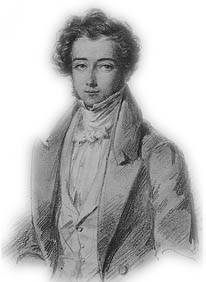 Alexis de Tocqueville was a French writer who went to North America to study American penitentiaries in the 1830s. He was a keen observer of American customs and institutions. When he asked to travel in the forest, Americans thought him mad:
Alexis de Tocqueville was a French writer who went to North America to study American penitentiaries in the 1830s. He was a keen observer of American customs and institutions. When he asked to travel in the forest, Americans thought him mad:
"In Europe people talk a great deal of the wilds of America, but the Americans themselves never think about them; they are insensible to the wonders of inanimate nature and they may be said not to perceive the mighty forests that surround them till they fall beneath the hatchet. Their eyes are fixed upon another sight: the march across these wilds, draining swamps, turning the course of rivers, peopling solitudes, and subduing nature." (From his famous work: Democracy in America)
Wilderness and its Close Ties to Religion
Wilderness was something that had be conquered. It was a threat to survival. It was dark, sinister and forbidding. It was evil. The first settlers of the New World found a wilderness far bigger and menacing than anything in Europe.
Because of its association with darkness and evil, wilderness at that time - and to some degree in modern times - has a close connection with religion. It follows, then, that religious and spiritual concepts can be used to describe wilderness. Since it is dark and sinister, wilderness is wicked and ungodly. By conquering wilderness, a pioneer is able to convert a place of wickedness (wilderness) to a place godliness (civilization). A pioneer, thus, is doing God's work.
Let's look at some religious terms which describe this relationship between wilderness and religion:
Regenerate means spiritually reborn. The Regenerative process is the process of becoming spiritually reborn. In relation to wilderness, it is the process of turning the ungodly and useless into something that beneficial to civilization. Indeed, that is what pioneers were doing. Wilderness was an ungodly place, a blight on the face of the earth, and they were turning it in something that was beneficial to humankind.
Unregenerate - means not converted to a belief. Not spiritually re-born. Wilderness is unregenerate. Wilderness is moral chaos.
Exceptions
There were a few exceptions to the prevailing attitude. The exceptions included: 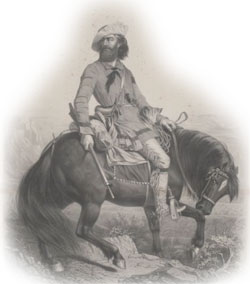
1) Mountain men (trappers) of the west (pictured to the right), and . . .
2) Voyageurs of the north country (Voyageurs are trappers that used canoes to transport goods - pictured below) .
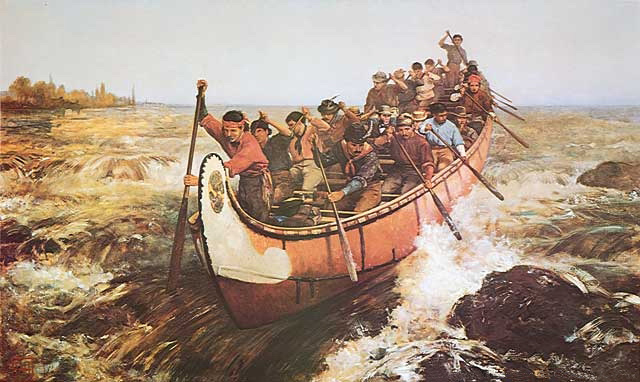
In both cases, they didn't need to change the landscape. They lived with it. They very quickly reverted to primitive lifestyles, and in some cases even joining Indian tribes.
Other terms:
Theism - Belief in God. (It isn't necessary to use reason or evidence like deists- nor do they believe God is the universe like Pantheists) Theists believe in a personal God, a God that involves himself in the lives of people.
Deism - Belief in God on evidence of reason and nature. (As opposed to theism who simply believe in God without any kind of reason). To deists the power of reason is very important. Deists believe that God doesn't involve himself in every day affairs.
Pantheism - God is the ultimate reality. Man and the material universe are only manifestations of this reality. The universe is God. God is the universe. God is not a personal God. Taoism (is an example).
Primitivism - Belief that qualities of the primitive (back to nature) or that early cultures are superior to contemporary civilization.
Changes Due to Literary and Artistic Influences
Americans harbored a strong hate for wilderness that had built up over the centuries. But there were some changes of thought afoot . . .
Romantic Movement
The first change in attitudes came from the literati through the Romantic Movement. The movement flowered in the 1700s and early 1800s. It is a style of literature and art (France, Germany, England & US) characterized by freedom of treatment as opposed to classic style which was regular, simplistic, balanced.
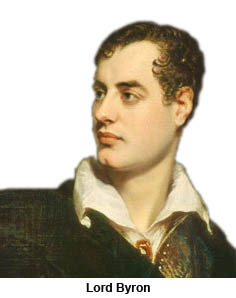 Romantics appreciated the beauties of nature. Primitivism was an important idea among romantics. Primitivists believed that man's happiness decreased in direct proportion to his degree of civilization.
Romantics appreciated the beauties of nature. Primitivism was an important idea among romantics. Primitivists believed that man's happiness decreased in direct proportion to his degree of civilization.
One of the most outspoken advocates of the wild was Lord Byron:
There is a rapture on the lonely shore.
There is society where none intrudes
I love not man the less, but nature more.
When De Tocqueville came to the US, he wanted to experience the "trackless" forests. He was a romantic.
The Ideas of Romanticism Appear in Early American Writings
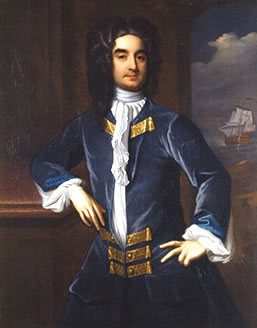 William Byrd (Surveyor). Born in Virginia, lived in London, then returned to the colonies. He was influenced by Romantic literature.
William Byrd (Surveyor). Born in Virginia, lived in London, then returned to the colonies. He was influenced by Romantic literature.
In 1728, Byrd began surveying. His History of the Dividing Line was the first written American commentary on wilderness which is not hostile. He calls the Appalachian Mountains the "Range of Blue Clouds."
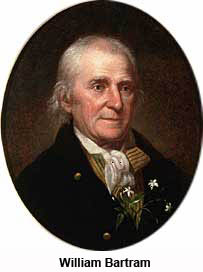 William Bartram (Botanist). In mid to late 1700's, a small number of naturalists began to view wild places from a different perspective. Wilderness, they came to believe, was not necessarily a forbidding place.
William Bartram (Botanist). In mid to late 1700's, a small number of naturalists began to view wild places from a different perspective. Wilderness, they came to believe, was not necessarily a forbidding place.
Of the early American naturalists, William Bartram wrote particularly well. He was a botanist and a romantic. In the late 1780's after traveling 5,000 miles throughout the Southeast US, he completed his famous Travels through North and South Carolina, Georgia, East and West Florida, the Cherokee Country, etc. He wrote of the beauty he encountered, used the word "sublime" which was the first extensive use of the word in American letters. He linked sublime with God's grandeur.
Others
There were very few that thought like Bryd and Bartram, but it was a beginning.
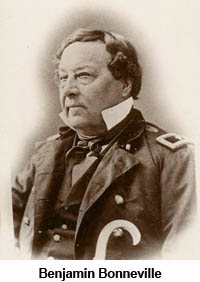 Gradually, we see evidence that frontiersmen, the ones that do battle with wilderness, adopting the ideas of the Romantics.
Gradually, we see evidence that frontiersmen, the ones that do battle with wilderness, adopting the ideas of the Romantics.
Benjamin Bonneville (1796-1878) said that returning to civilization displeased him compared to the stirring excitement of wilderness adventure.
John C. Fremont in an 1842 trip to Wind Rivers called the country "grand" & "magnificent" "romantic" scenery.
Slowly - The idea of wilderness is beginning to change in American minds. In the next class, we'll look at that change in thought as represented by artists.
[1] William Strauss and Neil Howe, Generations: The History of America's Future 1584 to 2069 (New York: William Morrow, 1991), p. 36.
[2] A copy of the paper in which I introduce the term "Modern Age of Adventure" is found here.
[3] William H. Goetzmann, New Lands, New Men : America and the Second Great Age of Discovery (New York: Viking, 1986).
[4] Roderick Nash, Wilderness and the American Mind (New Haven: Yale University Press, 1973)
Pub History: This page was originally located at the following URL:
https://www.isu.edu/~wattron/OLNotes1.html
[End]
